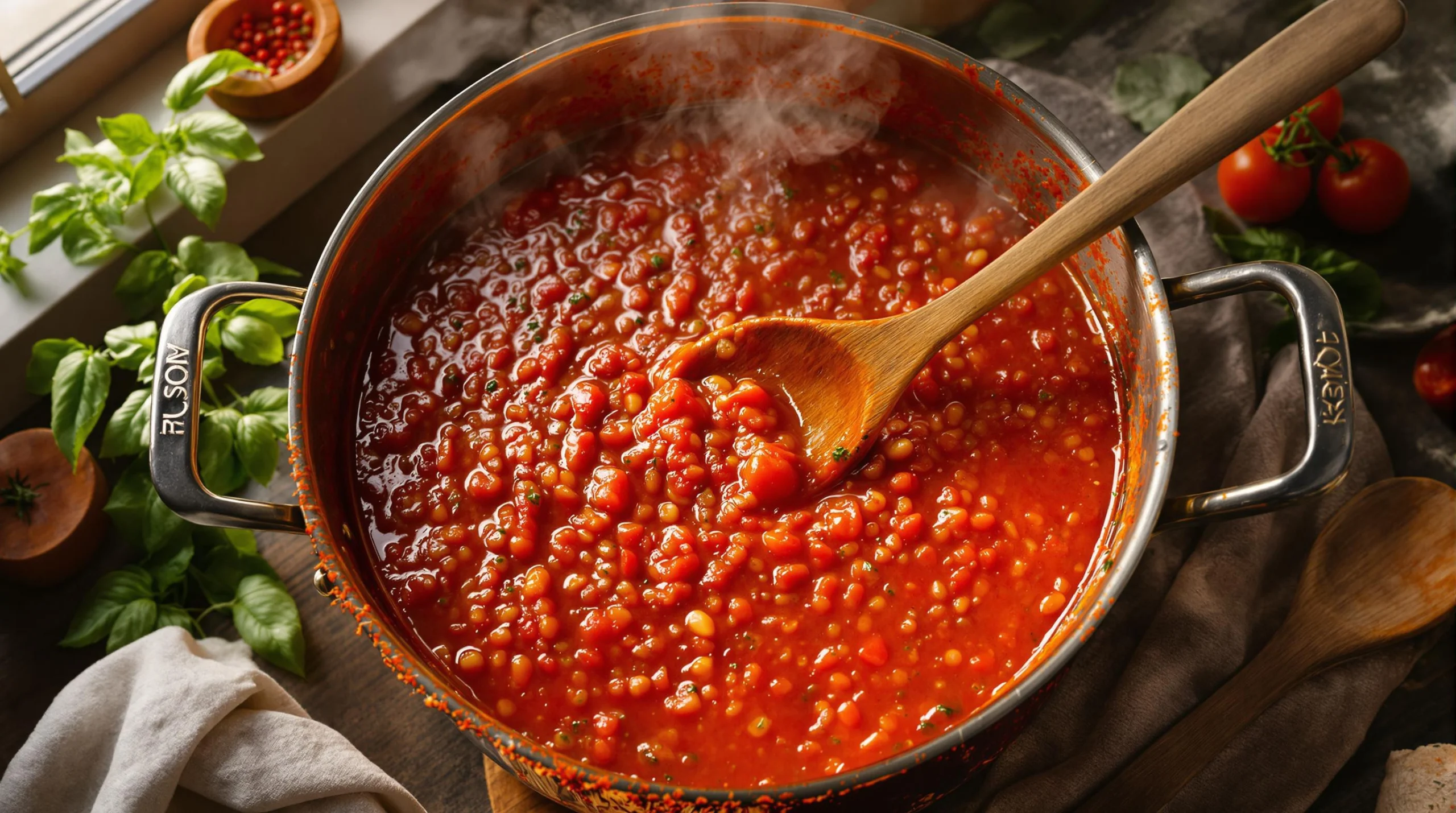As my grandmother always said, “La cucina povera è la più ricca” – poor cooking is the richest. This paradox lies at the heart of Italian tomato-based cooking, where humble pantry ingredients transform into works of culinary art. Growing up in my family’s restaurant, I watched my nonno perform what seemed like magic with canned tomatoes during winter months when fresh weren’t available. He’d whisper, “The secret is in treating canned tomatoes with the same respect as fresh ones.” Today, I’m sharing five authentic Italian recipes that honor this tradition – proving that “from the can” doesn’t mean compromising on flavor.
1. Nonna’s Classic Marinara Sauce
This Calabrian-style sauce forms the backbone of Italian-American cuisine, yet few home cooks understand the alchemy behind its development. The magic happens through patient reduction, not added ingredients.
When I apprenticed in Naples, my mentor slapped my hand when I reached for sugar to “fix” acidity. “Mai! Never!” he scolded. “Use carrot instead – nature’s sweetener.” This traditional technique balances acidity while maintaining authentic flavor profiles.
For this sauce, start by gently sweating – not browning – your aromatics. The onion and carrot should become translucent, releasing their natural sugars to create the foundation. When adding garlic (always last in the aromatic sequence), cook just until fragrant – about 30 seconds. Browning garlic introduces bitterness that will haunt your sauce for hours.
The most crucial step comes during the 2-4 hour simmer (I prefer the full four). Leave the pot uncovered, stirring occasionally as moisture evaporates and flavors concentrate. This isn’t just cooking; it’s transformation. Each hour develops deeper complexity until you achieve that quintessential Italian restaurant flavor that seems impossible at home.
Finishing with butter might seem unorthodox, but this classic Italian technique (called “mounting”) creates silky texture while tempering acidity. For an exceptional pasta experience, try this sauce with homemade flatbreads torn into rustic pieces.
2. Velvety Pink Cream Sauce
If marinara is the workhorse, pink sauce is the show pony – elegantly balancing acidity and richness. While not traditionally “old country,” this Italian-American fusion has earned its place in the modern Italian canon.
The technique here is all about proper emulsion. Add your cream gradually while whisking constantly to prevent breaking. Keep the heat low – patience is non-negotiable. When properly executed, the result should coat the back of a wooden spoon with a silk-like consistency.
Chef’s Note: When cooking with cream and tomatoes, always add a pinch of sodium bicarbonate (baking soda) to prevent curdling. This technique, taught to me by an 84-year-old pasta maker in Bologna, ensures your sauce remains velvety smooth regardless of acidity levels.
For a spectacular variation, try incorporating a splash of vodka before adding cream, similar to my 30-minute Nonna’s tomato sauce approach, but with added luxury.
3. Risotto al Pomodoro
In Northern Italy, rice often replaces pasta as the starch of choice. This tomato risotto demonstrates the versatility of canned tomatoes in creating luxurious texture without relying on excessive cream or butter.
The key difference from standard risotto? Patience. The addition of tomato acidity means the rice requires slightly longer cooking time to properly soften. Don’t rush this process – proper risotto should flow gently when plated, neither standing rigid nor running like soup.
The mascarpone finish (which can be substituted with cream cheese in a pinch) adds a tangy complexity that balances the sweetness developed during the long simmering process. For an elevated experience, try serving this alongside crispy roast potatoes prepared with my grandmother’s baking soda trick.
4. Italian Sausage & Peppers Stew
This rustic Southern Italian dish exemplifies the “cucina povera” philosophy – transforming humble ingredients into something extraordinary. The key lies in layering flavors: first developing fond (browned bits) from the sausage, then allowing the peppers to slowly caramelize in those rendered fats.
For authentic depth, add a splash of red wine after sautéing your vegetables but before introducing tomatoes. The alcohol will evaporate, leaving behind complex, fruity notes that elevate the entire dish. This technique creates a flavor profile reminiscent of slow-simmered stews with minimal effort.
5. Vodka Sauce: Modern Classic
Despite its relatively recent origin (1970s Italy), vodka sauce has become a cornerstone of Italian-American cuisine. The science behind this preparation is fascinating: vodka’s alcohol acts as a flavor carrier, enhancing the tomatoes’ aromatic compounds while introducing subtle peppery notes impossible to achieve otherwise.
The technique requires careful alcohol reduction – cook until you no longer smell alcohol vapors but before losing the backbone of flavor. This typically takes 7-10 minutes of gentle simmering after adding vodka.
For family meals, the alcohol cooks off completely, making this appropriate for all ages. If serving to those avoiding alcohol entirely, substitute white wine vinegar diluted with water (1:3 ratio) for a similar acidic foundation.
My students are often surprised to discover that proper vodka sauce contains far less cream than commercial versions. Like the perfect alpine fondue, restraint with dairy allows other flavors to shine through.
These five recipes prove that authentic Italian cooking isn’t about elaborate techniques or rare ingredients – it’s about respect for tradition, understanding flavor development, and honoring simplicity. Whether you’re creating a quick weeknight dinner or Sunday supper centerpiece, these pantry-friendly classics deliver restaurant-quality results that would make any nonna proud.
